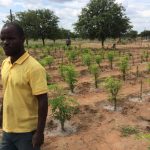It is going well with our Moringa plantations! We’ve got three and the number of trees planted arose in the last two years from 500 to 4200.
Moringa plantations play an important role in the development of becoming self-sufficient. Primarily as a cheap, always available and healthy food source for our kids and teachers. In addition, as an additional source of income; the harvest not used by the school itself, is sold on the market. But the plantations now also provide employment for the locals. Normally, harvesting take place 6 times a year.The leaves are then harvested, washed, dried, and cleaned of twigs. With an average of 1 400 trees per plantation is a tough job!
Moringa trees are also known as ‘Miracle Trees’. The Moringa leaves are a natural food supplement that contributes significantly to reducing malnutrition disease. When it comes to vitamins and minerals, Moringa scores as many as eight aspects better than other fruits and vegetables. So the leaves contain more iron than spinach, more Vitamin C than orange and more potassium than bananas.
The boil leaves with millemeal is part of African culture. An easy way to enrich the daily diet so, with a product from the garden.




